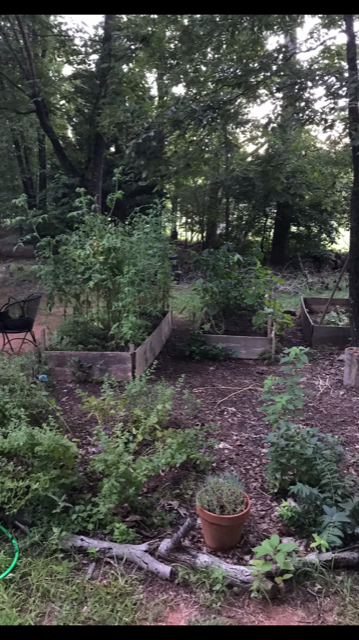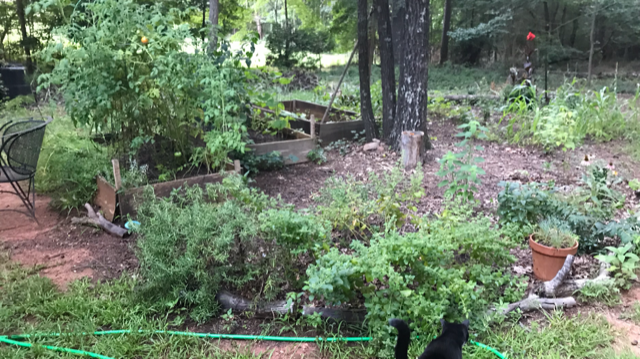This is a very short 5 minute presentation I gave when I interviewed for my former job at University of Georgia Extension in 2022. I believe Regenerative Gardening & Farming is the best way to protect and improve soil health, enhance environmental health , combat climate crisis, and improve our local, regional, and global food systems.
Veggies Fall 2023
I started 25 trays of seeds this year! I love seeds, and my favorite place to order organic seeds is Lake Valley Seed. Almost all the plants I grew this year I grew from seed.
I planted Broccoli, Cauliflower, Kale, Cabbages, Collards, Celery & Brussels Sprouts from seed in Espoma seed starting mix, and then transplanted them into my homemade compost & soil mix, with Espoma Plant Tone mixed in. I have ten beds total, and filled three of them with these plants spacing them 12-16 inches apart. I also add a couple trowel scoops of the compost/manure mix into the holes when I plant.





It rained torrentially for about two weeks in September. Everything I had already planted was pulverized from days and days of heavy rain, but luckily I had started lots of plants from seed & so I had extras to fill in. By then, it was a tad late for fall planting (first week of October). Update post soon with new photos of the plants. Organic is a bit slower, better for the environment, & tastier too! Harvesting Collards today!




Sun-loving Perennials for a Pollinator Garden
The University of Georgia Cooperative Extension offers a fantastic online publication with resources for schools, and home gardeners, to help create a pollinator garden. A pollinator garden uses specific plants to draw pollinators like bees, wasps, butterflies, and hummingbirds to a specific area.
Favorites for full sun beauty, and pollinator draw in my garden
Asclepius tuberosa “Butterfly Weed”
This plant is spectacular. I noticed a few growing wild down by the roadside at the edge of my heavily wooded property. I got the shovel and dug one up! I left the other three to continue growing there. I found out they don’t transplant well, but this one survived and has now been in my pollinator garden for two years. The butterflies absolutely love it, and they fight each other over the flowers.


Pollinator planting is especially useful for me because I also grow vegetables in my raised beds. The nearby pollinator garden helps draw more pollinators to my veggie blooms too-therefore increasing my yields! I also try to pick plants that have beautiful blooms, or are Georgia native plants, or both.
Echinacea purpurea
This simple Southeastern native Purple Coneflower is one of my all time faves. It keeps the bees very happy, and a smile on my face all summer.



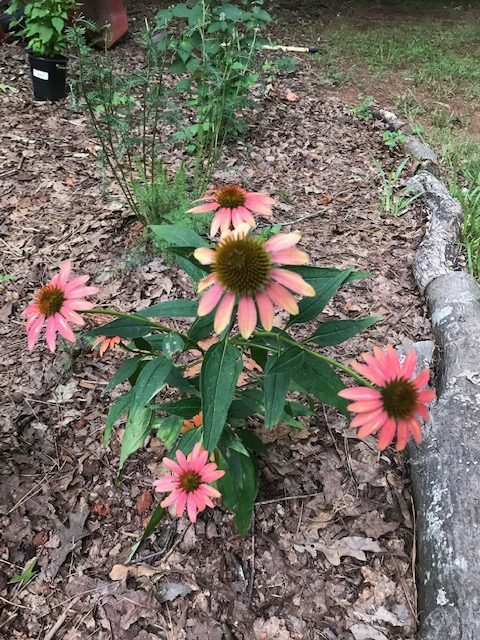
Agastache “Anise Hyssop”
One of my favorite new herbs, and therefore found all over my garden is the deer proof wonder Anise Hyssop. Delightful, long blooming, anise scented leaves, and pollinators all year make this a superstar favorite.
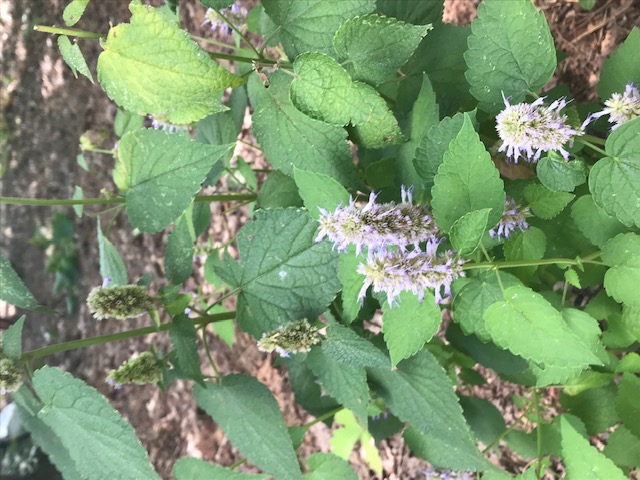
Lobelia cardinalis “Cardinal flower”


Another beautiful native plant. These bright red beauties are very charming and are hummingbird magnets. They begin to bloom in August, and the flowers march up the stem. I love watching the hummingbirds zooming in to feed from them. To my eye, the flowers also look like tiny hummingbirds.
Lantana ‘Sonset’
‘Sonset’ Lantana oozes summer heat & the colors can’t be beat. I bought three of these gorgeous, super drought tolerant, pollinator magnets while working at Cofer’s. Delivered from a nursery in Louisiana, the grower said it was the earliest, most cold hardy, and compact lantana ever. They are one of my favorite plants now, and the butterflies play in, and fight over the stunning color changing flower heads.


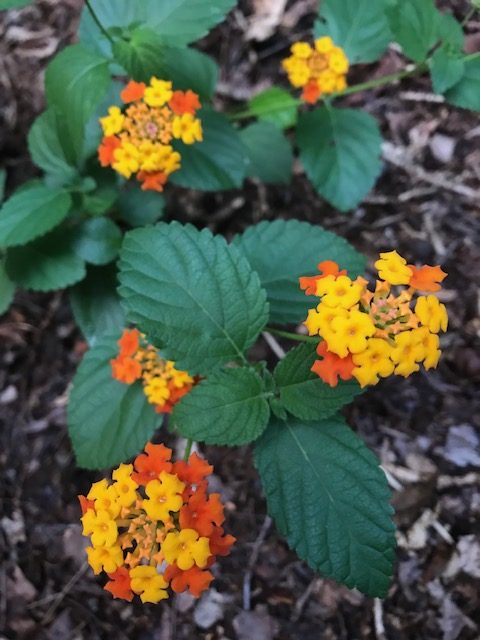
They are a smaller lantana-unlike that ‘Miss Huff’ showoff. These are 3-4 feet max, and stay smaller if keep minimally pruned.
Eryngium yuccofolium
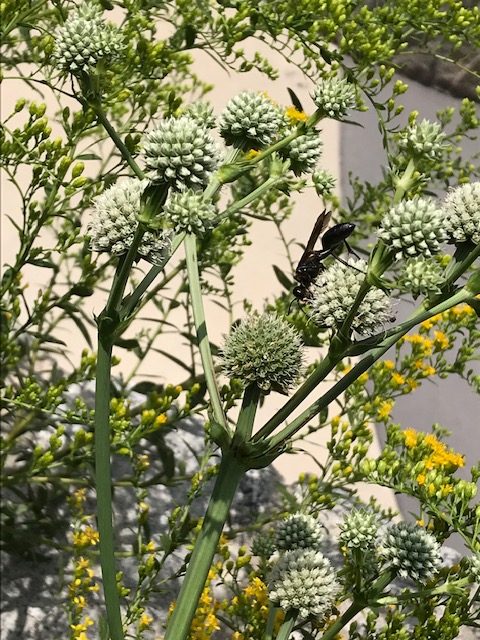
This plant absolutely hums and buzzes with every manner of wasp, bee, and flying insect. I have rarely seen so many on one plant. This plant has uses in herbal folk medicine (it is also known as Rattlesnake Master), and doesn’t seem very attractive at first glance. It has long, thin yucca like leaves with spiky balls topping each stem. Once you give it a second glance though, it is truly a fascinating, beautiful plant. It is super unique, and provides loads of pollinators to your garden.
Woodland Sunflower Helianthus divaricatus
These woodland sunflowers fill the area under my grand white oak tree just off the back deck. They are super pretty and dark green, and I love watching them grow. I saw many of these in the mountains at Black Rock Mountain State Park when I visited. They shine in the shade under the tree canopy, and pleasantly brighten up the roadsides and trailsides.
The State Botanical Garden of Georgia has an incredible program called Connect to Protect that provides educational programming using native plants to support pollinators like birds and insects, and promoting native ecosystems.
Get out there and start your pollinator garden today!
Happy Gardening!
Landscape Perennials for Spring Blooms
My favorite Spring blooming plants from March & April include a few old favorites, and some new plants. I work at Cofer’s now, and I haven’t had much time to write, but will soon. My next post will be about the fifth year of raised bed garden planting-which I finally got done this past week.
Early March Bulbs sleep all winter & then awaken to Spring Sunshine
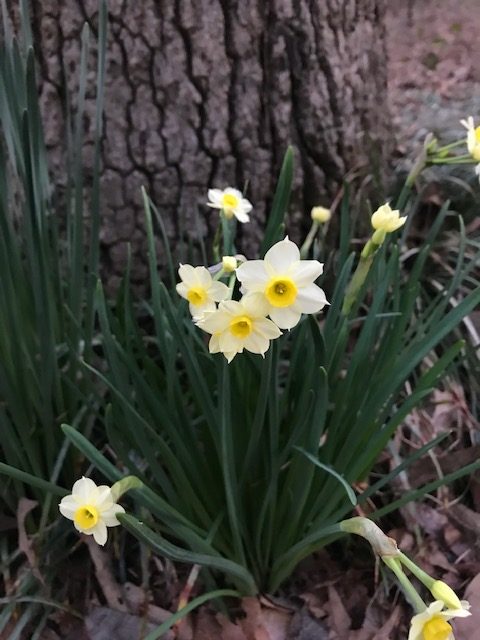


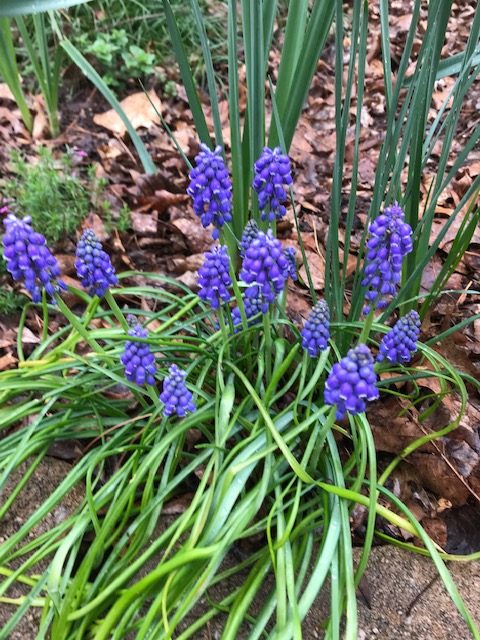
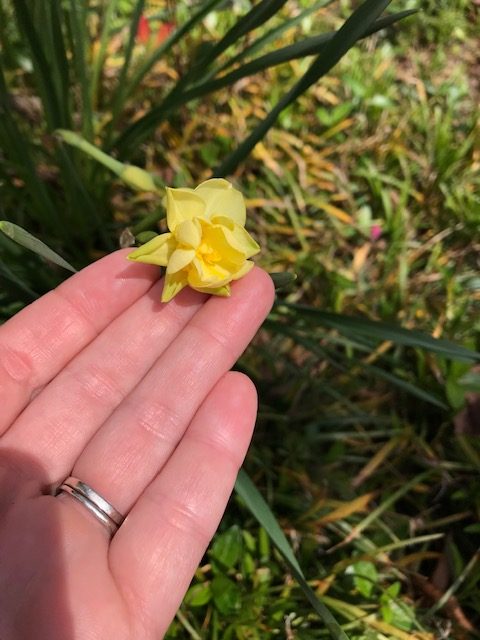
Late March-Early April Shrubs, Perennials, & Vines
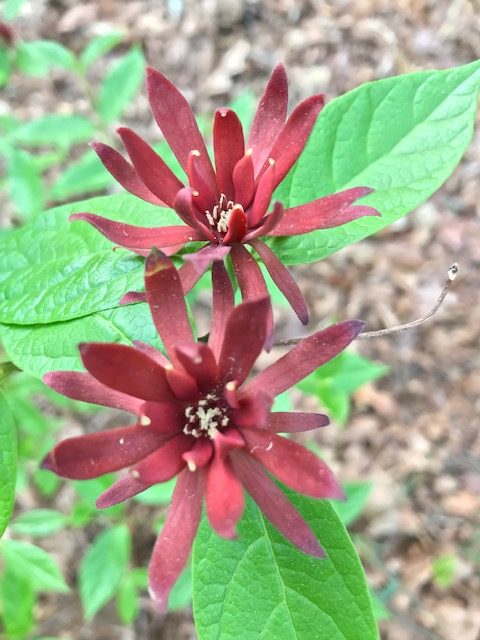
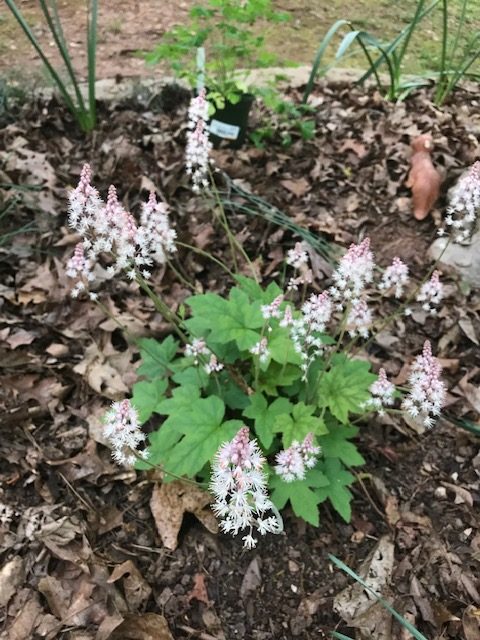
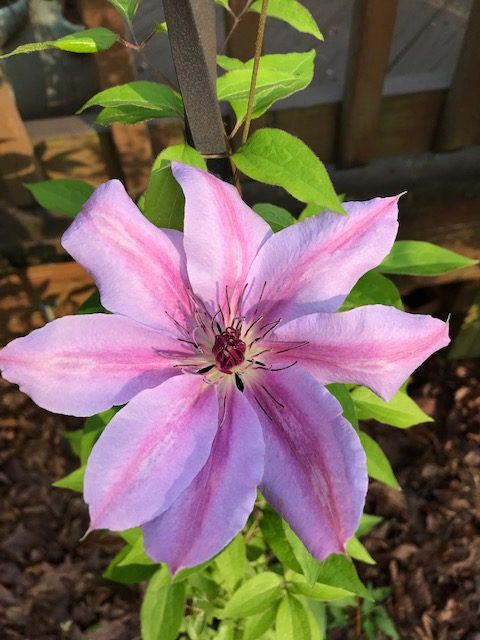
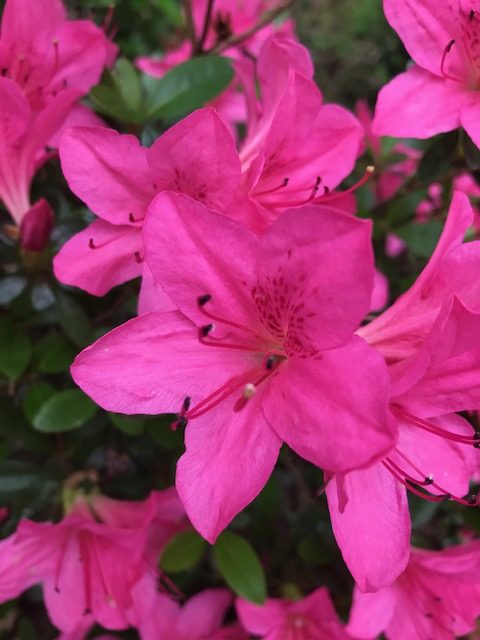
mid April
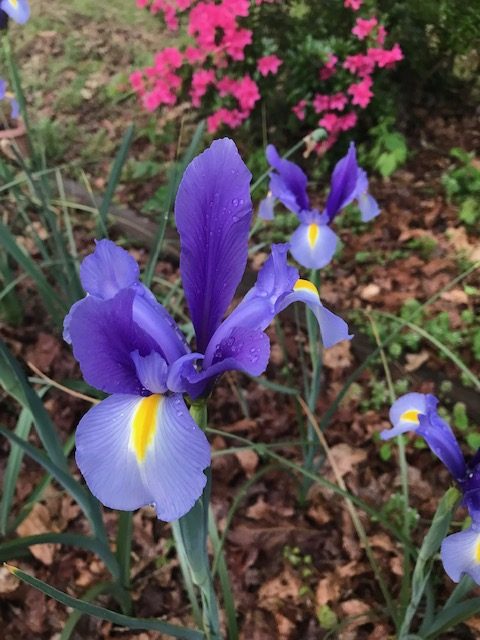
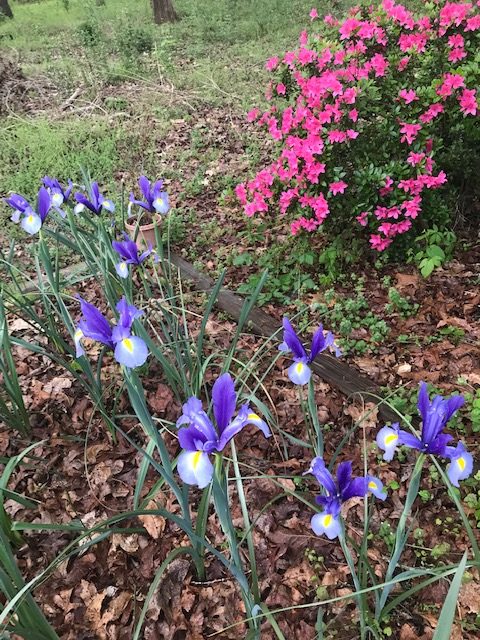
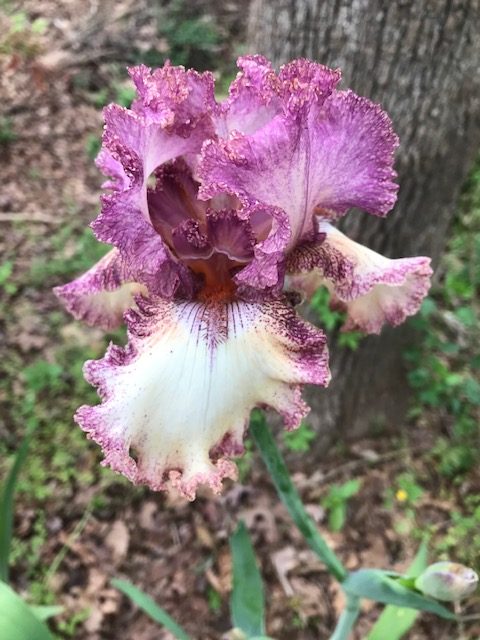
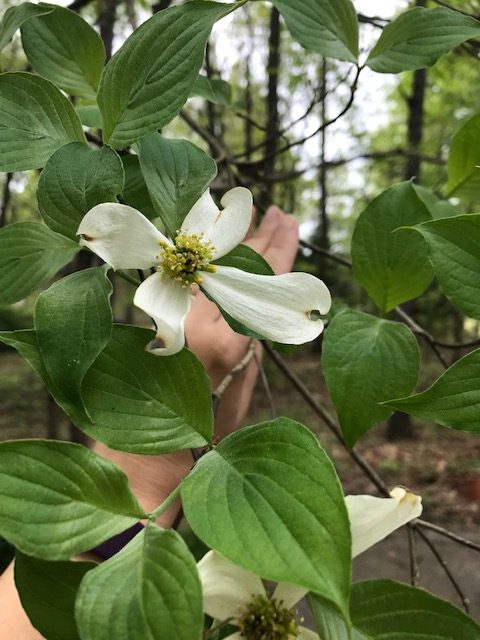

late April After studying her reflection Nature improves upon her artwork




Wow! So much happens in the garden in those few months.
The blooming is over now, but the plants live on growing & storing energy for more blooms.
Georgia Power Presentation
Created & Presented by Cari Misseri & Karin Blankenship
Presentation delivered to Georgia Power Retirees, March 2020.
Notes on Georgia Power gardening talk. 30 mins. This is a very rough copy of the notes I made for our presentation. I will include them with the presentation file itself soon.
Gardening for Fun, Form. & Function
Gardening should be fun! Don’t stress or try to make it perfect. Just be creative and enjoy it.
Sun, Soil, Water Simple
We will talk about: Spring Basics, Seeds & Plants, Container Gardening, Raised Beds, and Pest Control.
1. Spring basics
Organizing, Planting, and Dividing
Plants to add for spring interest-1 perennial & 1 shrub/tree for each season
Spring- Tiarella-Native Plant. & Azalea

Summer Interest/Great native pollinator plant-Echinachea-Coneflower. Abelia
Summer/Fall/Butterfly attractor-Salvia. Beautyberry-native

Winter- Pansies. Camellia
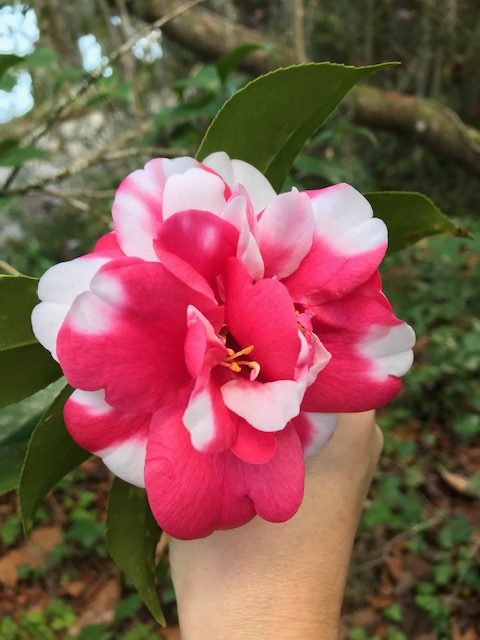
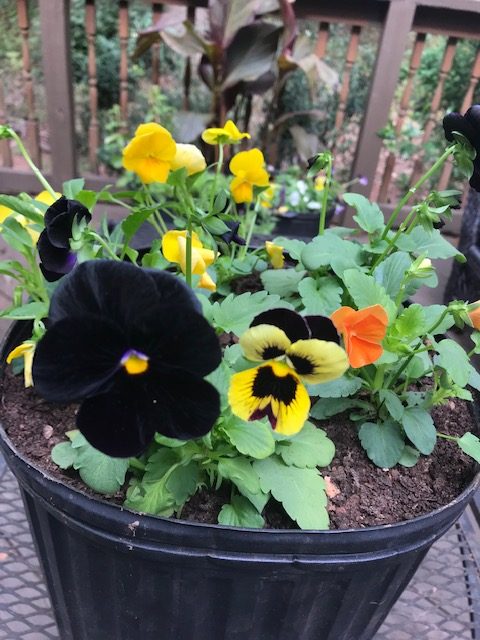
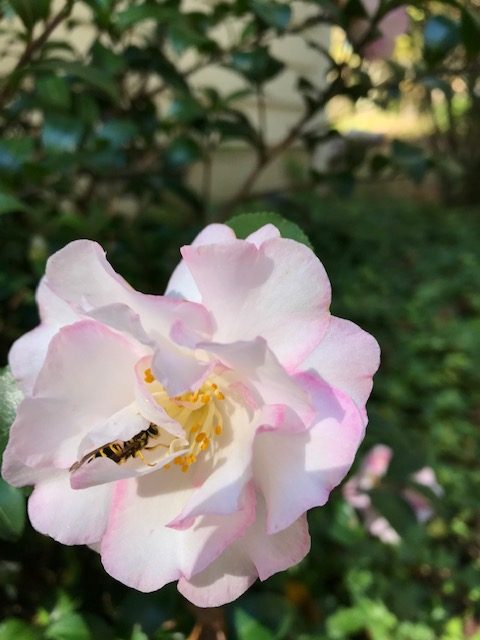
Planning
Take stock of your seeds or supplies, and see what you want/need for the upcoming year. Our last average frost is April 15th, so I usually wait until then to plant my raised beds. Now is a great time to plan for & plant seeds indoors for your spring and summer veggie garden.
2. Seed starting vs buying plants



3. Container gardening.
ALWAYS HAVE DRAINAGE HOLES IN CONTAINERS
4. Raised beds.
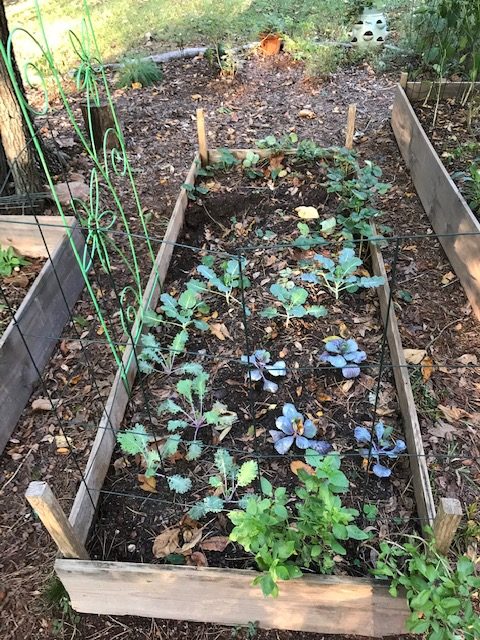
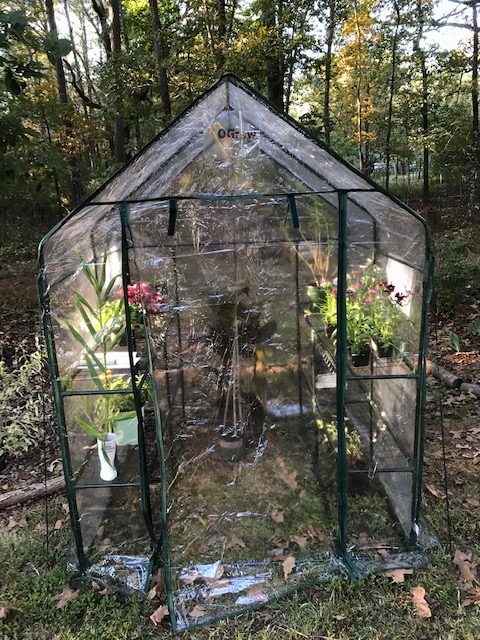
My beds are 3’ x 8’. I have 3 wood beds. Leave bottom open to native soil-no landscape fabric wanted. Untreated wood for edibles
Dirt is ⅓ native soil, ⅓ soil conditioner, ⅓ compost-I like mushroom compost. Add in an organic fertilizer like Espoma garden tone when you build the soil. Can also use a pre mixed soil, or straight compost. Plant dwarf or smaller varieties.
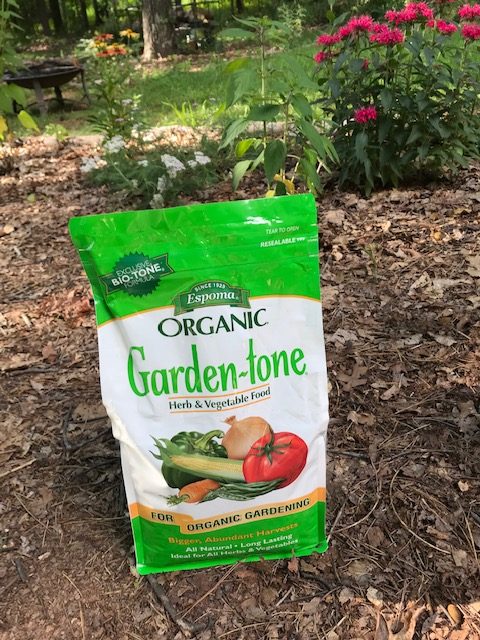
Fertilize throughout the seaon. I like organic fertilizer for many reasons but here are three:
Better for plants- slower release, no burning, slower more even growth and better plants
Better for people-natural fertilizer creates tastier vegetables hands down, no chemical concerns
Better for the environment-only use what you need, and not more. Then the excess does not run off into the streams, rivers and lakes, and create problems.
5. Responsible Pest Control
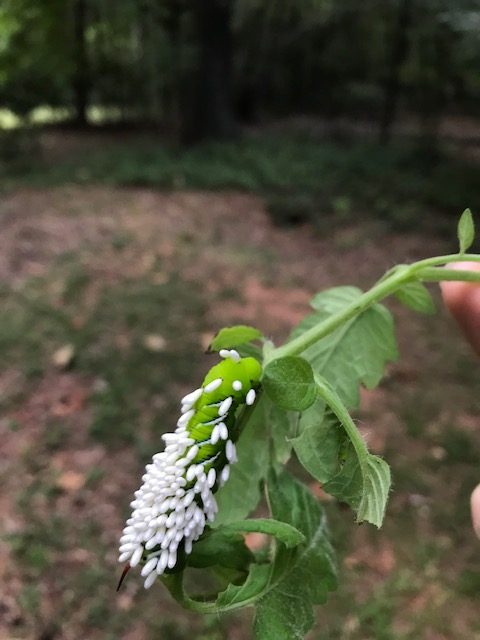
Encourage good stewardship and organic gardening and pest control where possible. Pick them off, or spray with water as 1st pest control method. Always read the instructions thoroughly before treating anything

Camellia Sasanqua, October Magic ‘Orchid’
I received this very special plant as a gift from my Mother-in-law. She is so thoughtful, and kind, and generous. She had this beautiful plant delivered to me, in memory of my Dad. He passed away at the age of 92, in early Nov. 2018. I could go on about him for hours. He was a teacher, a pilot, a gardener, a WWII Navy veteran, a great father, and a person of the highest possible honor and integrity. He loved gardening, growing vegetables, and canning and preserving them. And, he was really knowledgeable and skilled at it all.

The History of the Camellia is a very old, and quite magical story. I found a great wealth of information at the American society for Camellias website. They are located in Fort Valley, Georgia.
Camellias like dappled shade, but will tolerate some sun. They hate wet feet. Plant them high, and keep them away from areas that are too wet.
This Camellia named October Magic ‘Orchid’ is from a collection by Southern Living. This camellia is a Camellia Sasanqua, in contrast to a Camellia Japonica. Japonicas are larger plants, with larger leaves, and much larger blooms. They bloom later in the winter and into the early spring. Blooming from about January- March. Sasanquas are smaller shrubs that have more profuse blooming, but not as large blooms. They also bloom earlier in the season-from say October to January.
Wow, what an amazing plant. My new favorite, and it will always remind of my Father, and of my Mother-in-law, and the love of family.
I found a bit of folklore from Japan regarding the Camellia. It is said the spirits, and Gods come down from heaven to make their earthly home inside the camellia blossoms, when they visit those on earth. I hope that Dad and Mom will have many Camellia blossoms to choose from should they ever come to visit me. Their spirit lives on also in my love for gardening, vegetables, and all the astounding gifts nature provides.
Seed Starting Fall 2021
I tried several different methods of seed starting over the last 8 years, before I settled on this one. Good seeds plus good seed mix means you can’t go wrong, unless slugs are involved.
My best choice ever (seed startingwise) was to try a new product from my favorite organic fertilizer company, Espoma.
Their Espoma Seed Starting Mix is part of what made this my best garden year ever! Another part was the superior seeds I purchased from Baker Creek Heirloom Seeds.
I had some old container trays that I recycled & brought home from Cofer’s when I worked there last year. They have drainage holes and are perfect for starting seeds, but any container with drainage holes can be used.
I transplanted from the seed trays into recycled 4 pack trays on Sept 4th. I mix 1/2 organic mushroom compost, 1/2 organic topsoil, & add Espoma Plant Tone. Mix these together well, and transplant seedlings. They stay in that soil mix until they are ready for transplanting into the raised beds.
I started the first round of seeds in mid August, but had a slugtastrope & had to plant more seeds. I now move the baby seedling trays onto the deck at night to avoid slugs. This fall, I planted Broccoli, Kale, Cabbage, Brussels Sprouts, Collards & Cauliflower in seed trays.
Some types of veggie seeds achieve best results by direct sowing them into the place they will grow until harvest. This past week, I direct sowed carrots & radishes.
New posts coming soon about the expanded garden bed construction, summer harvests & more fall planting details. These babies are almost ready to go into the ground! I will likely plant them around end of September.
Happy Gardening!
5 Veggies for Raised Beds and Hot Summers
The growing season here in Georgia is super long & hot for summer veggies. April through October yields lots of produce.
Few memories of mine are more pleasant than those of my childhood in the garden with Dad – salt shaker in hand. We would spend hours out there. Fresh, homegrown, heirloom tomato plucked off the vine, and then devoured with a sprinkle of salt is as good as it gets.
In small spaces, I have grown some fantastic produce. I’d like to share 5 of my favorites discovered over the past seven years, chosen for best growth in small spaces, tastiness of produce, and quantity of yields.
#1. Tomato- top two varieties
Best Cherry Tomato Award goes to
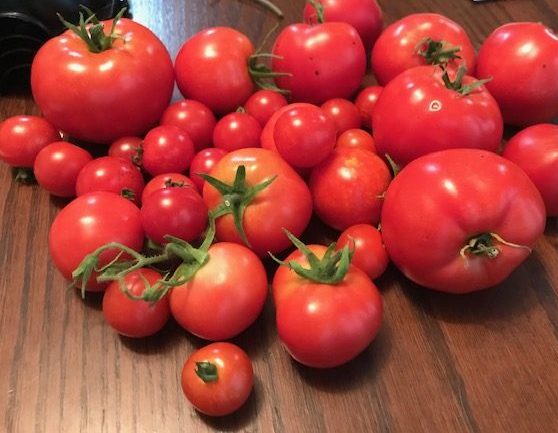
These indeterminate plants are super sturdy and aptly named as “husky.” They are tall, strong vines that need minimal support, and just keep producing the most delicious little 1 inch delights. I am instantly transported back to being a kid in the garden, with all the possibilities of the world ahead of me when I eat a fresh , homegrown tomato plucked from the vine.
While I don’t have the huge, in ground gardens Dad & Mom always made, I do have nine , 4′ x 8 raised wooden beds, a collection of containers, and a small patch of sunshine that the mighty oaks & hickories don’t shade out completely. I get 5-8 hours of sun per day in most of my beds, so they might produce better if I had more sun!
Best sandwich slicing Tomato award goes to
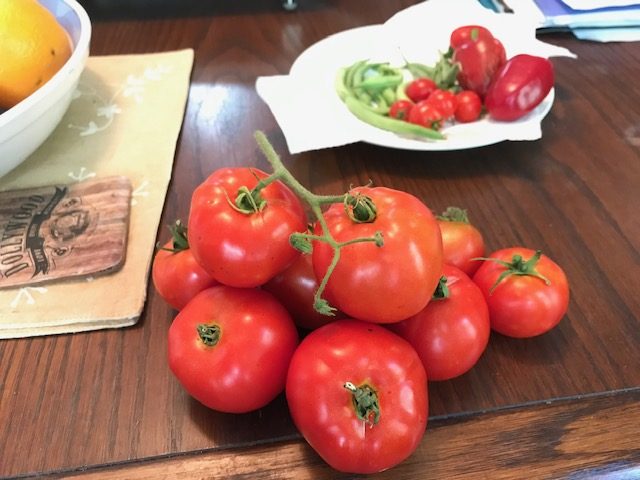
Parks Whopper Improved, Rutgers, & Husky Cherry Red Toms 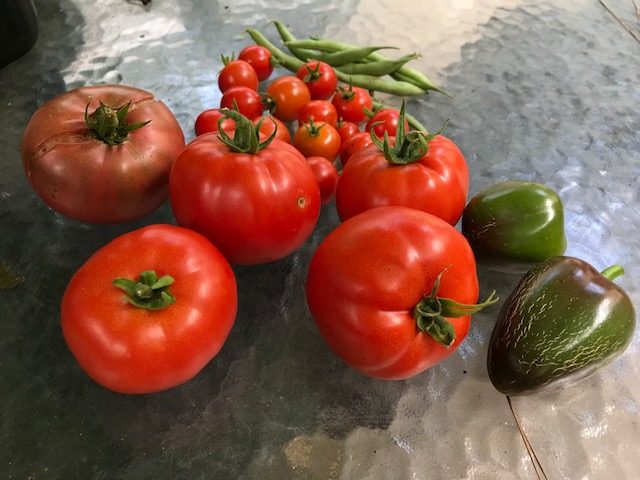
First Harvest 2020 
late July Harvest
#2 . Peppers Please!
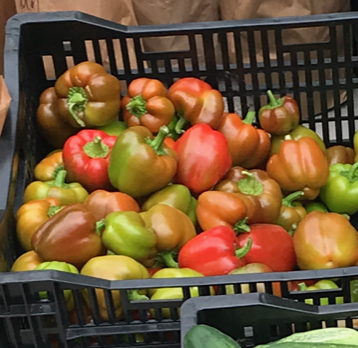
Chili Pie Pepper
All American Selection Chili Pie Pepper is a fabulous slightly hot, mini bell shaped pepper that reddens as it ages. These plants produce loads of peppers. They need a bit of support as they spread a little wide. There are somewhat shorter plants however and are well suited to raised beds.
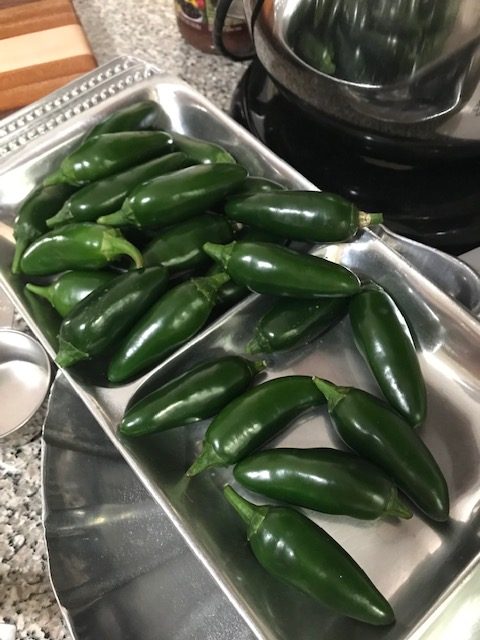
More Jalapenos for poppers 
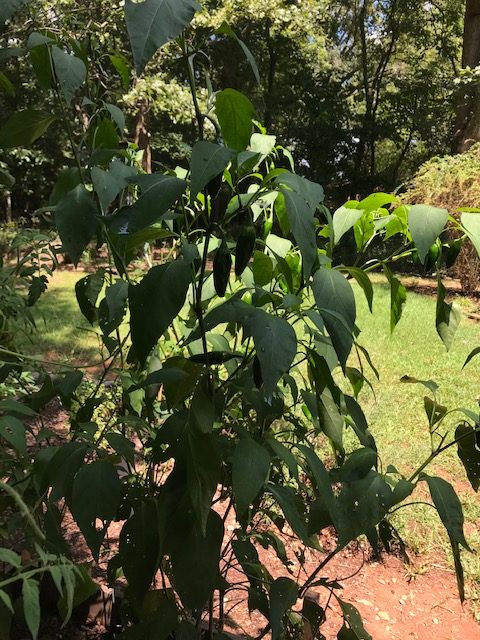
Look at al those Jalapenos!
I could go on for hours about my love of Jalapenos. But, I already have many times on this blog before. So, I will just say they are tall and beautiful plants that produce an incredible amount of peppers in one season. A Bonnie Plants 6 pack grown in my raised beds in about 10 square feet of bed produced over 200 peppers last year!
#3. Herbs
My two favorite herbs
Annual-Basil
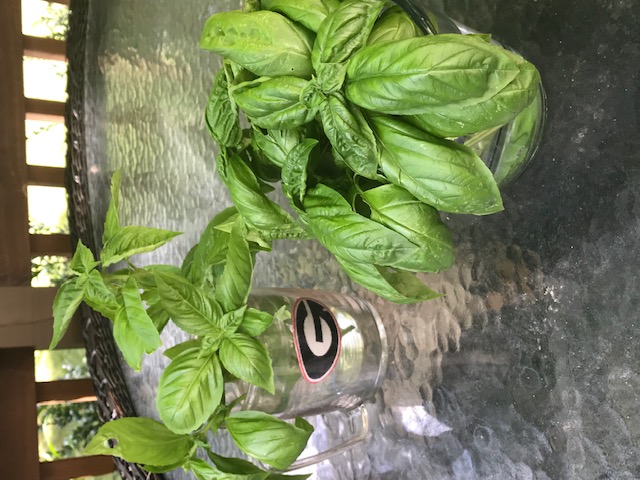
Genovese Basil 
Basil Babies Pinch those blooms 
Keep Harvesting for better plants 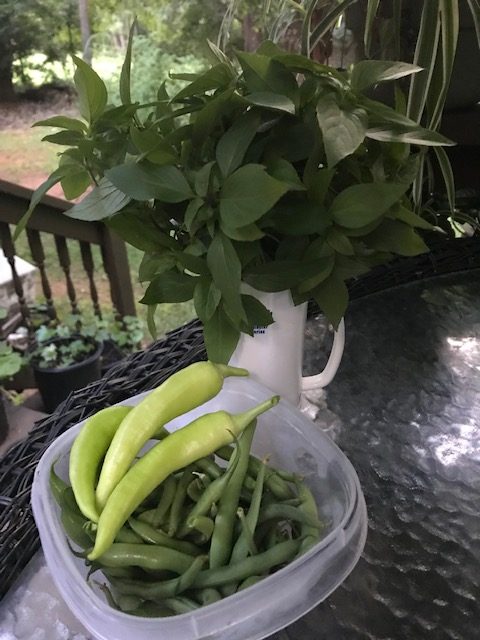
2020 Cinnamon Basil, Blue Lake Beans, Lola Peppers
Oregano
Perennial Oregano is a fantastic drying herb, and gives lots of leaves for many years from one plant.

I dry oregano every year and we use it so many things we cook. I bought one plant 7 years ago when I first began blogging and raised bed gardening. I harvest it and prune it back in the early spring before new growth. It is beautiful and very good for you. Oregano has been used for many thousands of years to enhance flavor and is touted for its herbal medicinal qualities as well.
#4. Beautiful Beans -Two Varieties
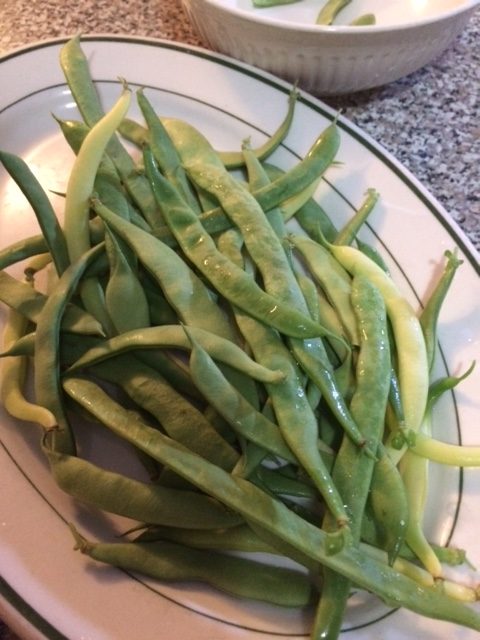
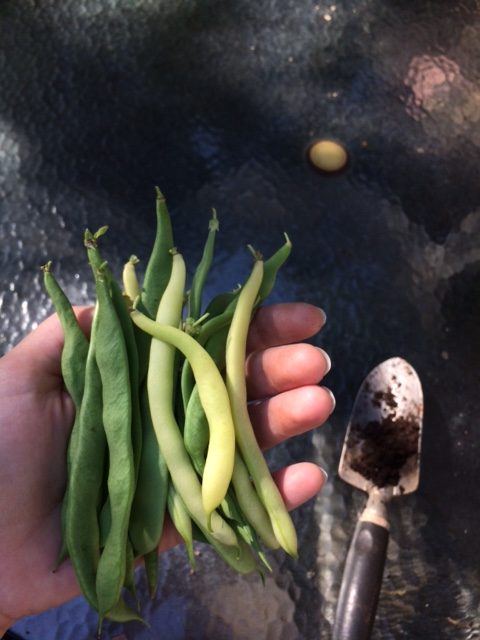
Kentucky Wonder, Cherokee Wax Beans 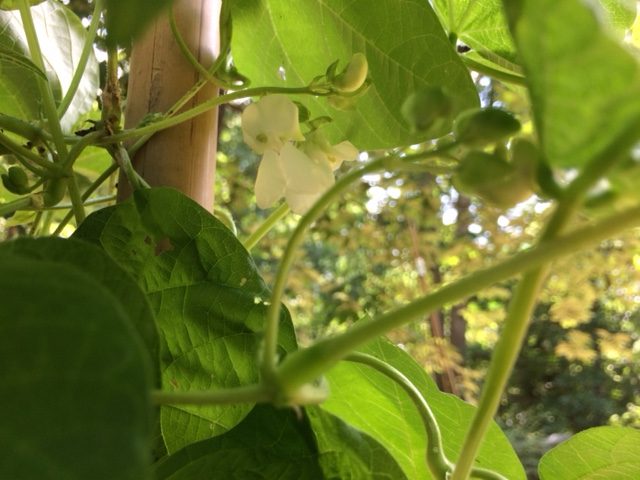
Bean Blossom 
Boil 10 mins, then saute with olive oil, sesame seeds, and salt & pepper. Yum.
Pole Bean Kentucky Wonder
was my Dads favorite and also one of mine. Check out this UGA publication on best home garden green beans for Georgia.
#5. Crunchy Cucumber
is a fantastic pickling cucumber. Vines are very productive, with delicious firm cucumbers.
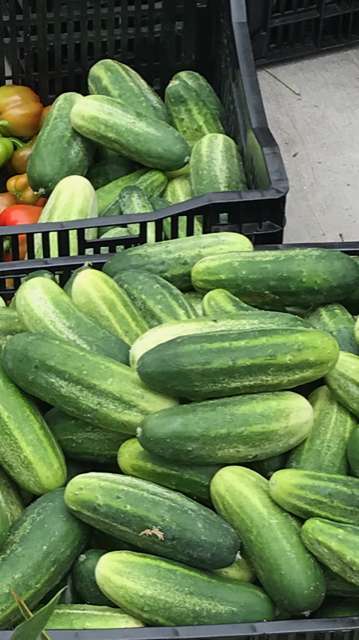
Arkansas Little Leaf Cucumber 
Homemade pickles made from Arkansas Little Leaf Cucumbers
Quick Link to my Best Raised Bed Construction post & Also to Espoma Fertilizer -my favorite fertilizer.
Ga Native: Woodland Sunflower
It took a good bit of searching online to finally identify this particular sunflower growing under one of my huge white oaks as, Woodland Sunflower or ‘Helianthus Divaricatus’. I knew it was some type of sunflower or aster, but wasn’t sure exactly which. I was able to identify it thanks to the multi branching blooms, the size of the plant, the appearance of the blooms and leaves, and photos of different varieties online at the USDA’s plant ID website.
This plant has a spreading habitat, and fills the shady area under the great oak. It does get some afternoon sun here, and the plant seems happy to take over the whole area. The long lasting summer blooms make the lackluster foliage as it dies back bearable. This sunshine yellow perennial returns early every year, and since it grows about 2-3 feet tall it makes a great plant for height at the back of a shady bed or border.
I saw many of these native Woodland Sunflowers while visiting the mountains at Black Rock Mountain State Park, in Mountain City, GA. I will write more about that amazing adventure in an upcoming post. I visited 10 state parks in Georgia in 2018, and am working on articles about hikes at those parks, and the plants I found along the way.
GA Native: Dwarf Crested Iris ‘Iris Cristata’
This native Iris, Iris cristata came from the Night Song Native Plant Nursery plant sale. I thought it died last summer, but it came back early this Spring and bloomed two times!
I placed the rhizome on top of a ridge of dirt at the front of the bulb bed, sandwiched between the huge 2-3 foot tall bearded Irises. The Iris cristata is super tiny, at about 6-10 inches tall.
The Georgia Native Plant Society is a great resource for information on Georgia’s native plants.
I have a few new posts in the works about the new raised garden beds, and all the plants and herbs I am growing this year.












